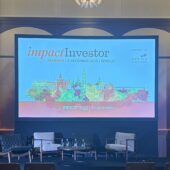The Bermuda-registered financial services group says the move reflects rising interest in impact investing from its private market clients

Apex Group said it was adding an impact investing product to the ESG assessment tools it offers to its private market clients. The company said its Impact Positive Solution supports investors and their underlying portfolio in measuring and improving impacts from their businesses and investments.
The new product adds to related solutions already offered by Apex on diversity, equality and inclusion (DEI) and climate and carbon emissions. This week, the firm also announced the launch of its EU Taxonomy Solution to ensure clients’ alignment ahead of growing disclosure requirements.
Apex, which provides financial services to asset managers, capital markets, private clients and family offices, has experienced growing demand for ESG-related offerings recently, according to Joshua Brunert, the firm’s global head of ESG product.

“There has been an increase in ambition overall. In 2019, ESG was on the backburner for most of the private markets, then it became a something of a compliance issue. But now it’s more of a competitive issue. Firms, and particularly funds, are trying to out-compete each other to demonstrate that they are having a positive impact in the world,” he told Impact Investor.
The Impact Positive Solution, involves a 5-step process, mainly carried out online. Firstly, a ‘do no significant harm’ assessment and exclusion screening is intended to ensure activities do not compromise other considerations. Then, impact data is tracked to assess its alignment with frameworks, methodologies and regulations, such as the Impact Management Project, the UN sustainable development goals, GIIN’s IRIS+ system, and the EU’s green taxonomy.
Thirdly, data is regularly collected via Apex ESG’s online platform. Fourthly, independent data verification and advisory is aimed at ensuring the integrity of impact data. Finally, impact reporting is carried out for key performance indicators that can be integrated within ESG and financial reporting in response to investor and regulator requests.
From ESG to positive impact
“We want to enable the firms that are doing ESG properly to stand out from the crowd when it comes to accusations of green and purpose washing. But we also want to help those that want to demonstrate their positive impact to have an easy way of being able to upscale that ambition from ESG to positive impact,” Brunert said.
He said Apex’s role was to walk clients through a complex journey.
“We help them understand what impact data they can collect – essentially, what frameworks are there, how to make sense of them and how they apply. Then we engage directly with the portfolio companies and support them to collect and monitor that data.
“Crucially, when the data is submitted it has to be verified and approved to make sure it is accurate and of good quality. So, we ensure there is documented evidence to back it up and assessed by ESG experts. Then, we help them to understand that data in the context of the wider market, and how they can drive improvements over time.”
Impact metrics comparability
Brunert acknowledges that comparability between impact metrics developed by different impact assessment providers remains problematic, given the wide variety of methodologies being deployed.
However, he says the situation is improving, as more impact metrics are designed with reference to common frameworks. These include industry initiatives such as IRIS+ and also the EU’s Sustainable Finance Disclosure Regulation (SFDR) and associated taxonomy, which aim to reduce greenwashing by requiring asset managers to provide more transparency about how they measure ESG impact and by classifying that impact.
“There has definitely been coalescing around key data points, be that on environmental or social issues, which enables us to make better comparisons. For example, the most common metrics that our clients ask us to use relate to greenhouse gas savings, and these have such common data points that it has become easier for us to understand and compare the data. But the caveat is that for, say, a biotech investment, where something novel is being manufactured, the situation will be very different, so it depends on the context.






